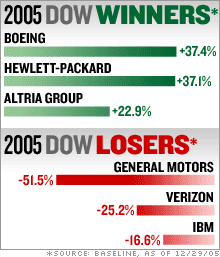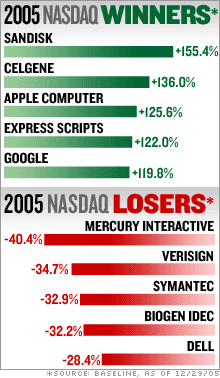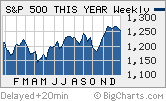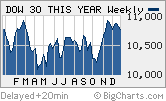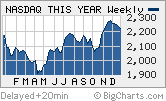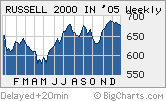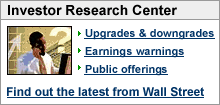|
Down day, tough year
Major gauges retreat in last trading session of 2005, at end of down week; Dow 30 down for the year.
NEW YORK (CNNMoney.com) - Stocks slumped Friday, at the end of a tumultuous 2005, sending the Dow industrials into the red for the year for the first time in three years. The Dow Jones industrial average (Charts) and the S&P 500 (Charts) index both lost 0.6 percent, while the Nasdaq composite (Charts) lost 0.5 percent.
For the year, the Dow lost 0.6 percent, the Nasdaq gained 1.4 percent, the S&P 500 gained 3 percent and the Russell 2000 small cap index gained 3.4 percent. Stocks slipped for the week and for the month of December, a typically strong month on Wall Street, as investors backpedaled after a strong start to the fourth quarter. Stocks had rallied between mid October and late November, briefly sending the Nasdaq and S&P 500 to 4-1/2 year highs. How the market will do in the months ahead will depend on variety of factors, particularly how well the economy continues to thrive. "If we continue to see economic expansion, the overall market will see better performance," said Maria Fiorini Ramirez, president of Maria Fiorini Ramirez Inc. However, she says that the S&P's total returns next year are unlikely to be in the double-digits. The weakness during the last week of 2005 was "a bit disturbing," said Donald Selkin, director of research at Joseph Stevens. "There was no Santa Claus this year." The year as a whole has been unremarkable for stocks in the United States, Selkin said, noting how well markets in Europe and Japan did relative to the United States. (For a look at 2005's biggest stock winners and losers, click here.) Nonetheless, the U.S. gains were sufficient to allow the major gauges to set some new records, albeit fairly dubious ones. Selkin noted that the Dow ended 2005 with its smallest percentage move either up or down since its inception in 1896. Additionally, the Nasdaq ended the year having made the smallest percentage move either up or down since its inception in 1971. And according to the Stock Trader's Almanac, the S&P 500's 2005 gain was the index's smallest percentage gain in an up year, since 1987. Looking forward
January promises to be a tricky month for stocks. Typically, early January is strong as investors buy back some of the stocks they've sold for tax purposes in December. However, a January advance is starting to look less likely, due to technical market indicators, said Paul Mendelsohn, president of Windham Financial Services. "It could get a little antsy in the next few weeks and stretching into mid January," Mendelsohn said. Beyond that, the market is likely to stick to a trading range again, as it did through a lot of 2005. "I think in the first quarter we'll fall back into the 1210 to 1246 range on the S&P 500," Mendelsohn said, citing a range that held stocks in tandem earlier this year. Beyond the technical factors, a lot of the concerns that have weighed on stocks recently haven't disappeared, Mendelsohn said, and are likely to continue to weigh on investors early next year. Although the Fed is expected to stop raising interest rates at some point in the first half of next year, the impact of the central bank's sustained hiking campaign will continue to be felt. In addition, oil prices remain high, the housing market is expected to keep slowing, worries remain about the consumer and the yield curve this week inverted for the first time since 2000, sometimes a bad sign for stocks. For more on why the stock market might have a tough time in 2006, click here. For a look at why the economy could be in for a slowdown in 2006, click here. For a look at small-cap stocks in 2006, click here. Click here for the outlook on financial stocks next year, and here for the outlook on insurance stocks. Friday's market
Market breadth was negative and volume was light. On the New York Stock Exchange, losers beat winners by nearly ten to seven on volume of 1.11 billion shares. On the Nasdaq, decliners topped advancers by nearly nine to seven on volume of 1.3 billion shares. Stock declines were broad based, with 28 out of 30 Dow issues falling Friday, led by Merck (Research), Wal-Mart Stores (Research), Boeing (Research) and AIG (Research). Boeing was the best-performing Dow stock of 2005 (see chart). A notable exception to the upside on the Dow was General Motors (Research), which continued to bounce back after hitting a 20-year low Thursday. Homebuilding stocks -- among the best performers of 2005 -- slumped, sending the Dow Jones Home Construction (Research) index down by 0.9 percent. Lucent (Research) and Ciena (Research) were among the names dragging down the Amex Networking (Charts) index. Google (Research) lost over 1 percent on reports that Rates Technology, a patent-holding company, is suing it regarding its web-based phone calling system. Analysts say damages from a lawsuit could reach $5 billion, over the next four years. Google was one of the best-performing stocks in the S&P 500 this year, gaining more than 118 percent. Other Web stocks fell too, dragging down the Goldman Sachs Internet (Charts) index by 1 percent. U.S. light crude oil for February rose 73 cents to settle at $61.05 a barrel on the New York Mercantile Exchange in an abbreviated session before the New Year's Day holiday. All financial markets are closed Monday in observance of Sunday's holiday. There was also another inversion of the yield curve Friday. For the fourth day in a row, the 10-year note yield dipped below that of the two-year -- an aberration that could signal an economic slowdown. (For more, click here.) Treasury prices slipped Friday, raising the yield on the 10-year note to 4.38 percent from about 4.35 percent late Thursday. Bond prices and yields move in opposite directions. The dollar fell versus the euro and the yen at the end of an otherwise strong year for the greenback. COMEX gold for February delivery rose $1.40 to settle at $518.90 an ounce.
In global trade, major Asian markets ended lower, but Japan's Nikkei finished the year with the biggest annual gain since 1986. European shares ended lower, but Britain's FTSE 100 ended the year with the best annual gains since 1999. |
| ||||||||||||||||||||||||||||||||||||||||||||||||

